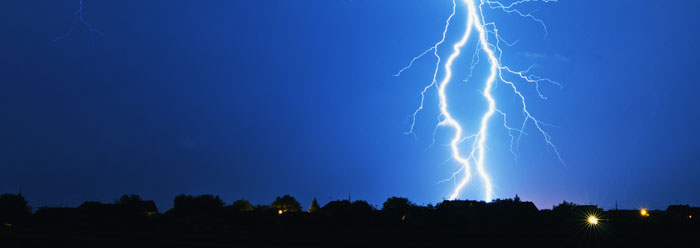Fulgurites are fossilized lightning strikes. The intense energy from a lightning strike essentially melts the ground. Lightning strikes can fuse rock, clay, or sand into fulgurites shaped like irregular hollow glass tubes. Physicist Don DeYoung wrote in 2013 in the Creation Research Society Quarterly that after 4.6 billion years, at the current lightning strike rate, every square meter of land should contain far more fossilized lightning strikes than it can even hold.1 New fulgurite research updates the numbers to bring this fulgurite problem into sharper focus.
Two Florida geoscientists collected and measured over 250 recent and ancient fulgurites from Polk County, Florida.2 In the online journal Scientific Reports, they published a way to estimate a lightning strike's energy by the dimensions of the fulgurite it produces.3
DeYoung estimated about a quarter of the 100 lightning strikes per second around the earth strike land. He further estimated that only one percent of the 25% land strikes generate fulgurites.
Pasek and Hurst suggested that only 45 bolts per second occur around the earth, instead of 100.4 The coauthors apparently would agree with DeYoung about the fraction of overland strikes that hit the ground, writing, "About a quarter of these strikes occur from a cloud to the ground, and hence the number of potential fulgurite-forming events is significant, with up to 10 fulgurites formed globally per second."1
This 10-per-second estimate assumes that all cloud-to-ground strikes form fulgurites. The odds of forming a fulgurite increase when lightning strikes bare soil, rock, or sand as opposed to ground covered by vegetation—even though fulgurites do form in soils found near trees or telephone poles that get struck. However, probably not every ground strike makes a fulgurite. So in calculating the total number of fulgurites in world history, a more conservative number works best. For example, what if only half of all ground strikes make fulgurites?
First, one could cut the Pasek and Hurst strike rate in half to have five strikes per second on Earth instead of 10. Second, one could multiply that by Earth's supposed evolutionary history of 4 billion years. Finally, dividing that product by an updated5 total land surface estimate yields over 3,928.7 fulgurites per square meter of land!6
Following DeYoung's even more conservative one percent, instead of half, of ground strikes making a fulgurite would still have generated about 78.6 fulgurites per square meter—or about seven fulgurites for every square foot of earth.7
So where are all the expected fulgurites? Or how about just half, or even a quarter of them? Fulgurites are so rare that most people have never even seen one! If the world is billions of years old, its continents should be riddled with them.
Of course, shrinking the evolutionary age for Earth down to a more scientific8 and biblical age of thousands of years solves the case of the missing fulgurites.
References
- DeYoung, D. B. 2013. A Survey of Lightning. Creation Research Society Quarterly. 49 (4): 281-286.
- Study provides a new method to measure the energy of a lightning strike. University of South Florida news release, via EurekAlert. Posted on eurekalert.com August 3, 2016, accessed August 3, 2016.
- Pasek, M. A. and M. Hurst. 2016. A Fossilized Energy Distribution of Lightning. Scientific Reports. 6: 30586.
- Pasek and Hurst did not make this estimated percent explicit, but it was implied in the numbers they did cite. Also, DeYoung estimated that only one percent of land strikes produce fulgurites.
- DeYoung used 1.28 x 1014 square meters for Earth's total land surface, but Universe Today suggests a slightly larger 1.46 x 1014 m2. Coffey, J. Surface area of the earth. Posted on universetoday.com December 24, 2015, accessed August 8, 2016.
- From: (45 earth strikes/sec) x (0.825 continent strikes/earth strike) x (0.25 soil strikes/continent strike) x (0.5 fulgurites/soil strike) x (3.1536x107 sec/yr) x (4x109yr) x (1/1.49e14m2)
- From: (45 earth strikes/sec) x (0.825 continent strikes/earth strike) x (0.25 soil strikes/continent strike) x (0.01 fulgurites/soil strike) X (3.1536x107 sec/yr) x (4x109yr) x (1/1.49e14m2)
-
Readers can find articles and other resources summarizing scientific evidence for a relatively young world on these pages:
ICR.org/recent-universe
ICR.org/thermodynamics
ICR.org/recent-creation
ICR.org/biological-clocks
ICR.org/RATE
*Mr. Thomas is Science Writer at the Institute for Creation Research.
Article posted on August 25, 2016.




















